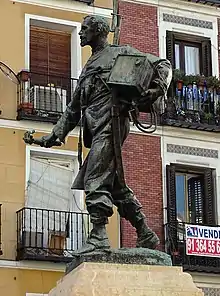 | |
| 40°24′37″N 3°42′26″W / 40.41025°N 3.70728°W | |
| Location | Plaza de Cascorro, Madrid, Spain |
|---|---|
| Designer | Aniceto Marinas (statue) José López Sallaberry (pedestal) |
| Material | Bronze, marble, limestone |
| Opening date | 5 June 1902 |
| Dedicated to | Eloy Gonzalo, the Hero of Cascorro |
The Monument to Eloy Gonzalo is an instance of public art in Madrid, Spain. It is a monument dedicated to Eloy Gonzalo, the so-called Hero of Cascorro. Erected on the plaza de Cascorro, it consists of a bronze statue of the aforementioned Cuban War hero authored by Aniceto Marinas, put on a stone plinth.
History and description
It is a monument dedicated to Eloy Gonzalo a Spanish soldier in the Cuban War independence who, in September 1896—during a siege by a party of about 2,500 Cuban mambises equipped with 70 mm battalion guns on a small regiment of Spanish soldiers garrisoned in the small village of Cascorro—[1] reportedly volunteered to his superiors in a nearly suicidal mission to infiltrate the enemy lines and fire the hut used as a warehouse for the weaponry of the enemy.[2] Reportedly equipped with a 10-liter gasoline can, a Mauser rifle, a torch and a rope (to tie himself allowing for the retrieval of his corpse in case he fell in action, as he was certain of)[2] he succeeded against all odds, helping to demoralize the enemy until the lift of the siege by General Adolfo Jiménez Castellanos,[3] only to die of dysentery in Matanzas in June 1897.[4]
The bronze statue designed by Aniceto Marinas (cast in Barcelona at Masriera y Campins' foundry)[5] represents a 2.30 metre[5] full-body Eloy Gonzalo wearing the rayadillo uniform characteristic of the Spanish soldiers during the conflict,[6] strapped at chest height by a rope, wielding a flaming torch with his right hand while he holds the oil can with his left arm, also carrying a rifle and a machete.[7] The plinth, made of marble and white stone, was designed by José López Sallaberry.[6][7]
The opposing sides of the pedestal feature two inscriptions reading "el ayuntamiento de madrid a eloy gonzalo, 1901" (the Ayuntamiento de Madrid to Eloy Gonzalo, 1901") and cascorro 1897, respectively.[6]
It was unveiled at its original location at the Plaza de Cascorro—mentioned at the time as Plaza del Rastro—on 5 June 1902,[8] matching it with the inauguration of a number of outdoor sculptures in Madrid on the occasion of the celebrations for the coming of age of King Alfonso XIII (delayed several times by bad weather),[8] featuring notable figures such as Bravo Murillo, Agustín Argüelles, Lope de Vega, Francisco de Quevedo, and Goya.[6][9]
References
- Citations
- ↑ Pando Despierto 1998, p. 50.
- 1 2 Pando Despierto 1998, p. 51.
- ↑ Pando Despierto 1998, p. 52.
- ↑ Pando Despierto 1998, p. 54.
- 1 2 Portela Sandoval 1997, p. 137.
- 1 2 3 4 "Descubrimiento de estatuas". El Imparcial. Madrid. XXXVI (12630). 6 June 1902. ISSN 2171-0244.
- 1 2 Salvador Prieto 1989, p. 311.
- 1 2 "Inauguración de estatuas". La Época. Madrid. LIII (18670): 3. 5 June 1905. ISSN 2254-559X.
- ↑ "Inauguración de estatuas". La Época. Madrid. LIII (18.671). 6 June 1902. ISSN 2254-559X.
- Bibliography
- Pando Despierto, Juan (1998). "Cascorro, 'hombre' y estatua" (PDF). Anales del Museo de América. 6: 49–58. ISSN 1133-8741 – via Dialnet.
- Portela Sandoval, Francisco José (1997). "La marina y el 98, en la escultura española" (PDF). Cuadernos Monográficos del Instituto de Historia y Cultura Naval. Madrid (30) – via Ministerio de Defensa.
- Salvador Prieto, María del Socorro (1989). "Monumentos escultóricos erigidos en Madrid para celebrar la coronación de Alfonso XIII". Anales de Historia del Arte. Madrid: Universidad Complutense de Madrid (1): 305–316. ISSN 0214-6452.